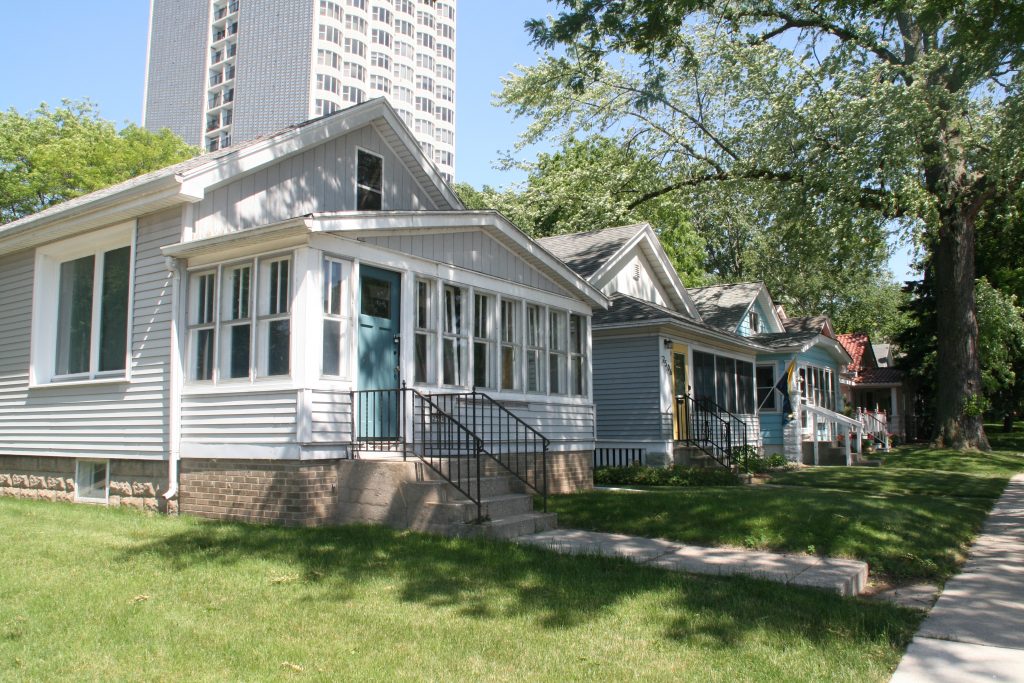New Housing Permits in Wisconsin ‘Way Behind’ Level in Early 2000s
New WPF report also finds permits for single family homes lag behind multi-family permits.

Houses on the 2500 block of S. Superior St. in June 2022. Photo by Jeramey Jannene.
A new report from the Wisconsin Policy Forum finds that while permitting rates for building new housing have increased since the onset of the COVID-19 pandemic, they still trail permitting levels in the early 2000s.
Mark Sommerhauser, policy researcher and communications director for the Wisconsin Policy Forum, told WPR’s “Wisconsin Today” that building levels stayed relatively low for years after the 2008 financial collapse.
“We’re still way behind where we were in the early 2000s,” Sommerhauser said. “Most critically, our housing inventory is feeling the impacts of years and years of very low levels of new construction, basically from 2008 onward for more than a decade.”
The forum’s report looked at the rates of both single and multifamily housing permitting statewide. They found that the state’s peak permit activity was between 2002 and 2004. Over the past three years, both types of permitting were down, with single-family permitting rates being nearly half of 2002-2004 levels.
Permitting rates climbed in 2021, but fell or stagnated in years after
The group’s research finds that housing permitting rates in 2021 jumped significantly compared to the previous decade, especially with multifamily housing. But these rates decreased in 2022 and stagnated last year.
Sommerhauser said 2021 was something of a “sweet spot” for new housing.
“In late 2021 and early 2022, we saw a really large increase in mortgage interest rates, Sommerhauser said.” “I think that, more than anything, is really the biggest factor in terms of why we didn’t sustain the increases or build on those the increases that we saw in 2021 into 2022 and 2023.”
Todd Mandel is the executive director of the Wisconsin Partnership for Housing Development, a nonprofit group which builds and helps other organizations build affordable homes to rent or buy. He said there is a lot of uncertainty as costs fluctuate.“A brief story of one little project we did: We had to wait almost a year and a half for the construction pricing to come back to us. It exploded and it was well past anything we could afford,” Mandel said. “And finally, the construction pricing finally fell enough after we waited 18 months that we could afford to do the project. And then by the time that happened, interest rates accelerated well past what we could afford.”
Growing divide between multifamily, single family housing
Since 2021, data show a stark divergence in the types of housing projects that are receiving permits.
“There’s just very little question that statewide, in virtually every metro area, we’ve seen a really significant uptick in multifamily housing permitting,” Sommerhauser said. “What we have not necessarily seen is a corresponding increase in single-family (permitting).”
Single-family permitting increased by around 21 percent in recent years. But that’s compared to a greater-than 60 percent increase in multifamily permitting.
“What we see is that in some metro areas, including our second largest metro area, and our fastest growing metro area, Metro Madison, we’ve actually seen a little bit of a decrease in single family permitting,” Sommerhauser explained. “So that, I think for anyone who’s a prospective homebuyer, is pretty concerning.”
What can be done to increase new housing?
Sommerhauser said certain factors like the cost of building materials and mortgage interest rates are out of the control of state or local policymakers. At the state level, he said policymakers can focus on tax cuts or regulatory changes to make construction cheaper.
Mandel said that for local governments, the creation of buildable lots affects both the creation of affordable housing and making existing housing affordable.
“By having lots that have to be a certain shape, or you can only have a certain density, you inevitably drive up prices. You artificially create a constrained market. And anytime there’s a constrained market, there’s going to be price inflation,” Mandel said.
Mandel said current approaches to lot sizes create a scenario that forces housing to be a certain size that prospective buyers or renters may not want.
“Imagine going to the grocery store and you’re like, ‘I’d like a pound of ground beef.’ And the grocery store is like, ‘Nope, sorry, we only sell ground beef in 3/4, two-pound, and 10 pound packages.’… that’s in essence what you have in all municipalities all over the country,” Mandel said.
But even with local and state efforts, Mandel said the amount of time it can take for new construction to affect local housing costs will vary.
“A community that sort of goes all-out and says, ‘all hands on deck’ and does a whole-of-government solution to this problem — 2 to 3 years to bend that curve is a reasonable time projection,” Mandel said. “It will more likely be some other macroeconomic force that changes the housing market for them, versus their own actions.”
New report finds housing permitting in Wisconsin lagging behind pre-2008 levels was originally published by Wisconsin Public Radio.
If you think stories like this are important, become a member of Urban Milwaukee and help support real, independent journalism. Plus you get some cool added benefits.





















